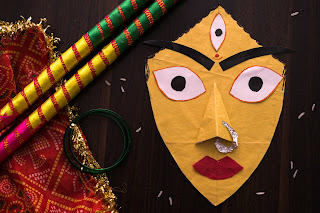9 nights of India festival (understand the Navratri of India)
The Vibrant Celebration of Indian Navratri Festival
Introduction: Navratri, the word itself, translates to 'Nine Nights,' and in India, it is one of the most awaited and vibrant festival. This grand celebration, spanning nine nights and ten days, is dedicated to the worship of the divine feminine energy and is marked by fervent dance, music, and devotion. It's a time when India comes alive with colorful and joyous celebrations, showcasing its rich culture and traditions. In this article, we will delve into the significance, rituals, and exuberant festivities of Navratri.
The Significance of Navratri: Navratri is celebrated in honour of the goddess Durga, who represents the power of the divine feminine. This festival is celebrated in various forms and with unique traditions across India. In the northern and western parts of the country, it is primarily dedicated to Goddess Durga, while in the eastern regions, it focuses on Goddess Durga's victory over the demon Mahishasura. In the southern states, Navratri celebrates the victory of Goddess Chamundeshwari over the demon Mahishasura.
The Colors of Navratri: One of the most fascinating aspects of Navratri is the tradition of wearing different colours each day. Each colour symbolizes a different aspect of the divine feminine and holds a special significance:
Day 1 - Yellow: Yellow represents the brilliance and brightness of the goddess.
Day 2 - Green: Green symbolizes new beginnings and growth.
Day 3 - Grey: Grey represents the strength and power of the goddess.
Day 4 - Orange: Orange signifies the transformative and creative energy of the divine.
Day 5 - White: White is a symbol of purity and peace.
Day 6 - Red: Red represents the fierce and passionate aspect of the goddess.
Day 7 - Royal Blue: Royal blue is the color of divine energy and power.
Day 8 - Pink: Pink symbolizes hope and the love of the goddess.
Day 9 - Purple: Purple represents the grace and charm of the divine.
Fasting and Feasting:
During Navratri, many devotees choose to fast as an expression of their devotion. Fasting rules can vary, but commonly include abstaining from grains, onion, garlic, and non-vegetarian food. The fast is broken with a special meal each day. On the other hand, the festival also provides an opportunity for food enthusiasts to savour a variety of delectable dishes. Special snacks like sabudana khichdi, Vrat Dosa, and fruit chaat are popular during this time.
Goddess Durga's Idol:
The centrepiece of Navratri celebrations is the beautifully decorated idol of Goddess Durga. Elaborate and artistic pandals or temples are constructed to house the idol, and devotees flock to these places to seek her blessings. The atmosphere is charged with devotion and spirituality.
The Grand Finale - Dussehra:
with this 10th day is the concluding day which is celebrated on the occasion of victory of good on the evil, the victory of Great lord ram on the evil king Ravan, in some parts of India it is also believed that this day represents the victory of goddes Durga on evil king Mahisasura.
Garba and Dandiya Raas:{we will post a separate post for this to understand the garba nights of INDIA} Navratri is synonymous with vibrant dance forms like Garba and Dandiya Raas. Garba is a traditional dance that involves dancing in concentric circles around a lamp or an idol of the goddess, often accompanied by live music. Dandiya Raas, on the other hand, involves dancing with sticks, creating a rhythmic and energetic performance. Both dances bring people together and create a sense of community and festivity.





Comments